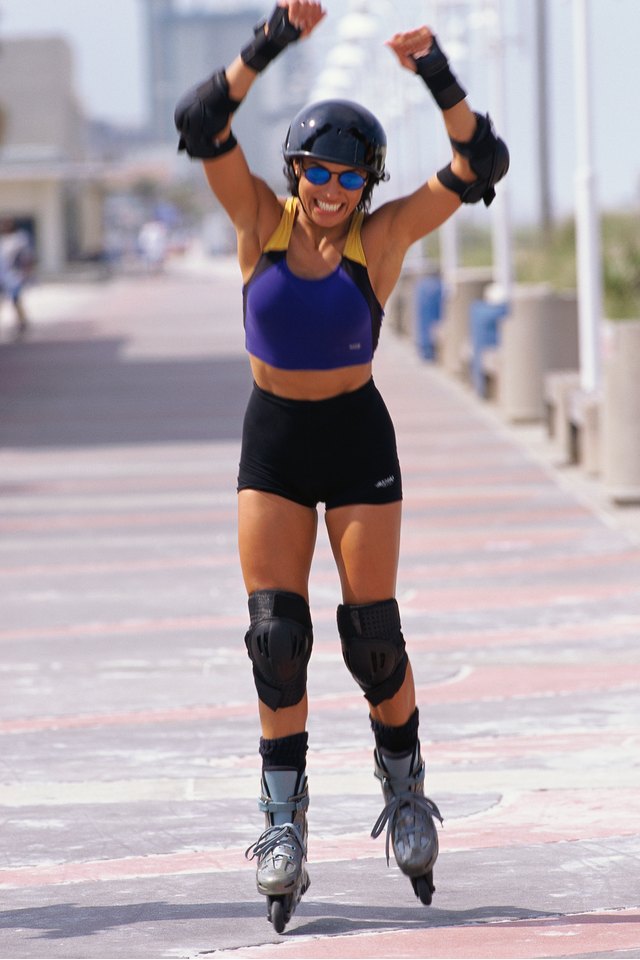How to Protect Ankles While Rollerblading

Although rollerblading is a low-impact sport, The Consumer Product Safety Commission reported an average of over 32,000 inline skating injuries every year from 2003 to 2007, according to the National Safety Council. Most injuries affect the upper body, but ankle injuries are one of the most common injuries to the lower extremities.The firm boot of an inline skate provides good ankle support when the skate fits properly, but fit is key. Protecting your ankles means not just following proper skating technique but also shopping smartly for your inline skates.
Selecting Skates
Shop for skates after a day of activity to compensate for any swelling of the feet that occur while rollerblading.
Pick skates for your gender, especially if you are a woman. While women can wear unisex skates, those designed especially for a woman better fit a woman’s narrower Achilles tendon and lower position of the calf muscle, notes Liz Miller, author of “Beginner's Guide to Inline Skating.”
Look for skates that lace up and buckle at the top. The combination provides a more secure fit for ankle support.
Squeeze the plastic support in the boot. It should be firm and unmovable.
Try on skates wearing a pair of thick, absorbent athletic socks -- the same type of socks you’ll wear when skating.
Wear the skates for at least 15 minutes before making a purchase. When laced and buckled, the skates should feel snug, but not so tight that any part of your foot feels pressure.
Skating
Stretch before skating. To prevent ankle injuries, focus on your feet: Flex and point your toes and rotate your ankles in circles.
Kick your feet into the back of your rollerblades before lacing and buckling up.
Warm up by gently skating around for five minutes.
Match your skating location to your skating ability. If you are a new skater, begin on a large patch of level grass. Empty tennis courts and parking lots are also good places to learn.
Bend your knees when you skate to lower your center of gravity. Skate with a wide stance if you are new to the sport. Skate with a shoulder-width stance if you are an experienced skater. A narrower stance gives you better control for tricks, but a wide stance helps beginners maintain balance.
Tips
If you have had ankle injury before, talk to your doctor about the benefits of taping your ankle. According to Minnesota Sports Medicine, taping the ankle provides additional support for the ankle tendons, ligaments and muscles. Do not tape your ankle if you have not had an injury. Most research shows taping is not beneficial for those who haven’t had ankle injuries, and taping may actually make you more susceptible to injury from improper taping.
Ask a professional at a sporting goods store to show you how to examine the skates for wear over time. Learn how to adjust the wheels, bearings and breaks.
Warnings
Many injuries occur when skaters do not wear the proper safety equipment. Wear a helmet, wrist guards and elbow and knee pads.
References
- National Safety Council: Inline Skating Safety
- Sportverletz Sportschaden:Injury Pattern Caused by Aggressive Inline Skating
- Der Unfallchirurg: Trendy Inline Skating Sports. Pattern of Injuries and Groups at Risk]
- Journal of Pediatric Orthopedics: In-line Skating Injuries in Children: A 10-Year Review
- Get Rolling: How to Shop for Your First Pair of In-line Skates
- KidsHealth: Safety Tips: Inline Skating
Writer Bio
Ivy Morris specializes in health, fitness, beauty, fashion and music. Her work has appeared in "Sacramento News and Review," "Prosper Magazine" and "Sacramento Parent Magazine," among other publications. Morris also writes for medical offices and legal practices. She holds a Bachelor of Arts in government-journalism from Sacramento State University.
